tires TOYOTA RAV4 HYBRID 2020 Warranties & Maintenance Guides (in English)
[x] Cancel search | Manufacturer: TOYOTA, Model Year: 2020, Model line: RAV4 HYBRID, Model: TOYOTA RAV4 HYBRID 2020Pages: 260, PDF Size: 8.54 MB
Page 192 of 260
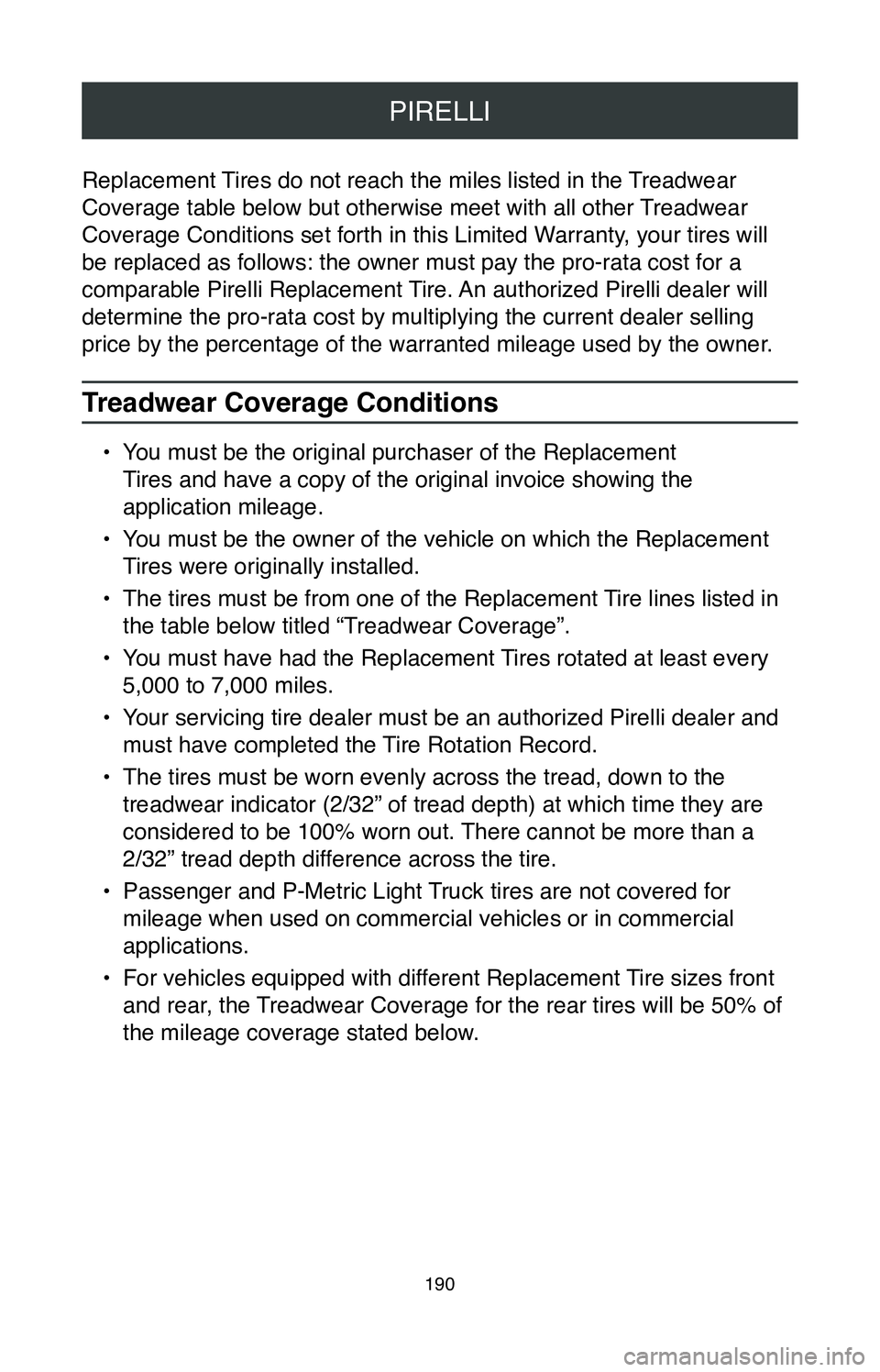
PIRELLI
190
Replacement Tires do not reach the miles listed in the Treadwear
Coverage table below but otherwise meet with all other Treadwear
Coverage Conditions set forth in this Limited Warranty, your tires will
be replaced as follows: the owner must pay the pro-rata cost for a
comparable Pirelli Replacement Tire. An authorized Pirelli dealer will
determine the pro-rata cost by multiplying the current dealer selling
price by the percentage of the warranted mileage used by the owner.
Treadwear Coverage Conditions
‚ÄĘ You must be the original purchaser of the Replacement
Tires and have a copy of the original invoice showing the
application mileage.
‚ÄĘ
You must be the owner of the vehicle on which the Replacement
Tires were originally installed.
‚ÄĘ
The tires must be from one of the Replacement Tire lines listed in
the table below titled ‚ÄúTreadwear Coverage‚ÄĚ.
‚ÄĘ
You must have had the Replacement Tires rotated at least every
5,000 to 7,000 miles.
‚ÄĘ
Your servicing tire dealer must be an authorized Pirelli dealer and
must have completed the Tire Rotation Record.
‚ÄĘ
The tires must be worn evenly across the tread, down to the
treadwear indicator (2/32‚ÄĚ of tread depth) at which time they are
considered to be 100% worn out. There cannot be more than a
2/32‚ÄĚ tread depth difference across the tire.
‚ÄĘ
Passenger and P-Metric Light Truck tires are not covered for
mileage when used on commercial vehicles or in commercial
applications.
‚ÄĘ
For vehicles equipped with different Replacement Tire sizes front
and rear, the Treadwear Coverage for the rear tires will be 50% of
the mileage coverage stated below.
Page 193 of 260
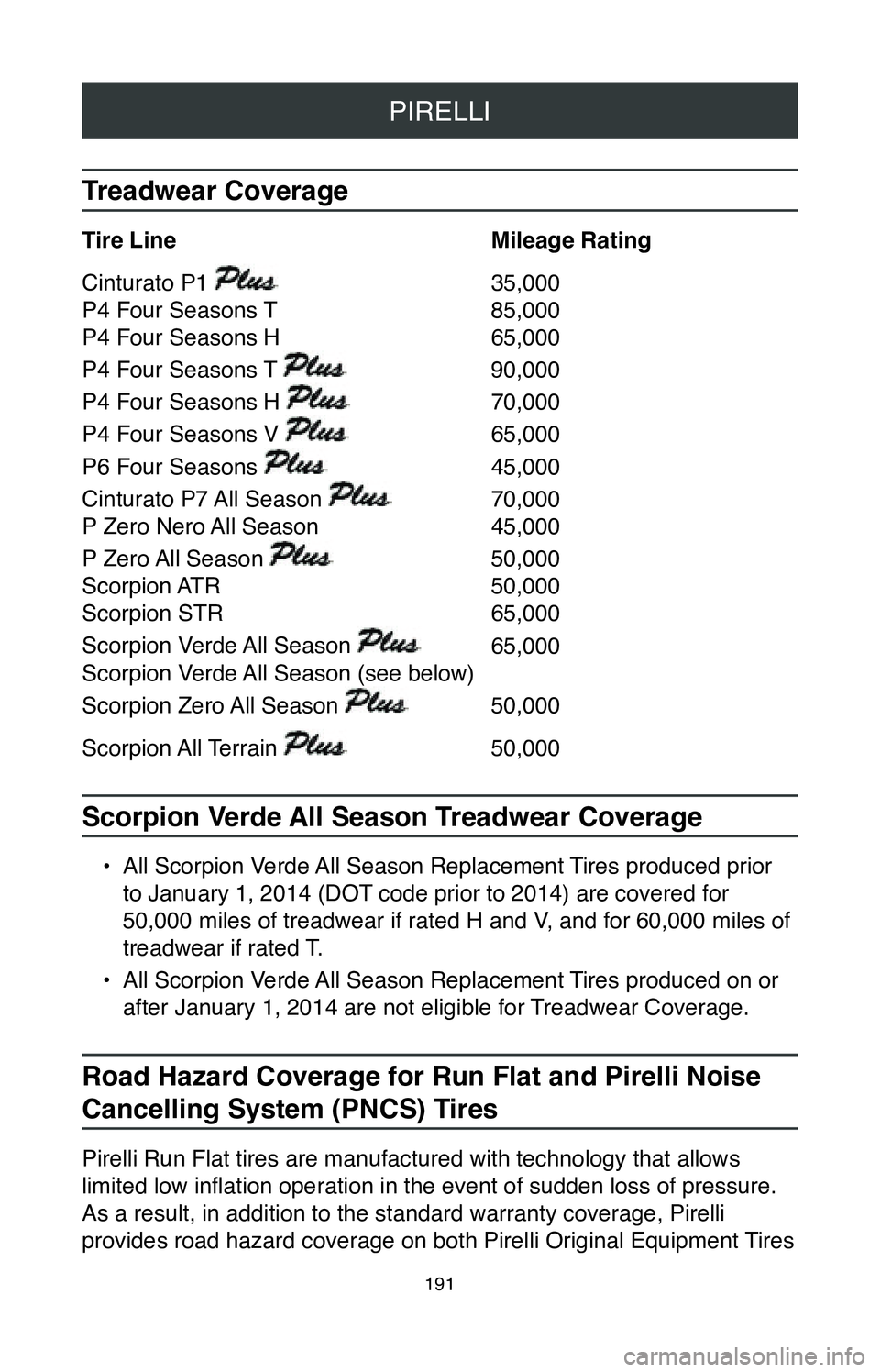
PIRELLI
191
Treadwear Coverage
Tire Line Mileage Rating
Cinturato P1
35,000
P4 Four Seasons T
85,000
P4 Four Seasons H
65,000
P4 Four Seasons T
90,000
P4 Four Seasons H
70,000
P4 Four Seasons V
65,000
P6 Four Seasons
45,000
Cinturato P7 All Season
70,000
P Zero Nero All Season
45,000
P Zero All Season
50,000
Scorpion ATR
50,000
Scorpion STR
65,000
Scorpion Verde All Season
65,000
Scorpion Verde All Season (see below)
Scorpion Zero All Season 50,000
Scorpion All Terrain
50,000
Scorpion Verde All Season Treadwear Coverage
‚ÄĘ All Scorpion Verde All Season Replacement Tires produced prior
to January 1, 2014 (DOT code prior to 2014) are covered for
50,000 miles of treadwear if rated H and V, and for 60,000 miles of
treadwear if rated T.
‚ÄĘ
All Scorpion Verde All Season Replacement Tires produced on or
after January 1, 2014 are not eligible for Treadwear Coverage.
Road Hazard Coverage for Run Flat and Pirelli Noise
Cancelling System (PNCS) Tires
Pirelli Run Flat tires are manufactured with technology that allows
limited low inflation operation in the event of sudden loss of pressure.
As a result, in addition to the standard warranty coverage, Pirelli
provides road hazard coverage on both Pirelli Original Equipment Tires
Page 194 of 260
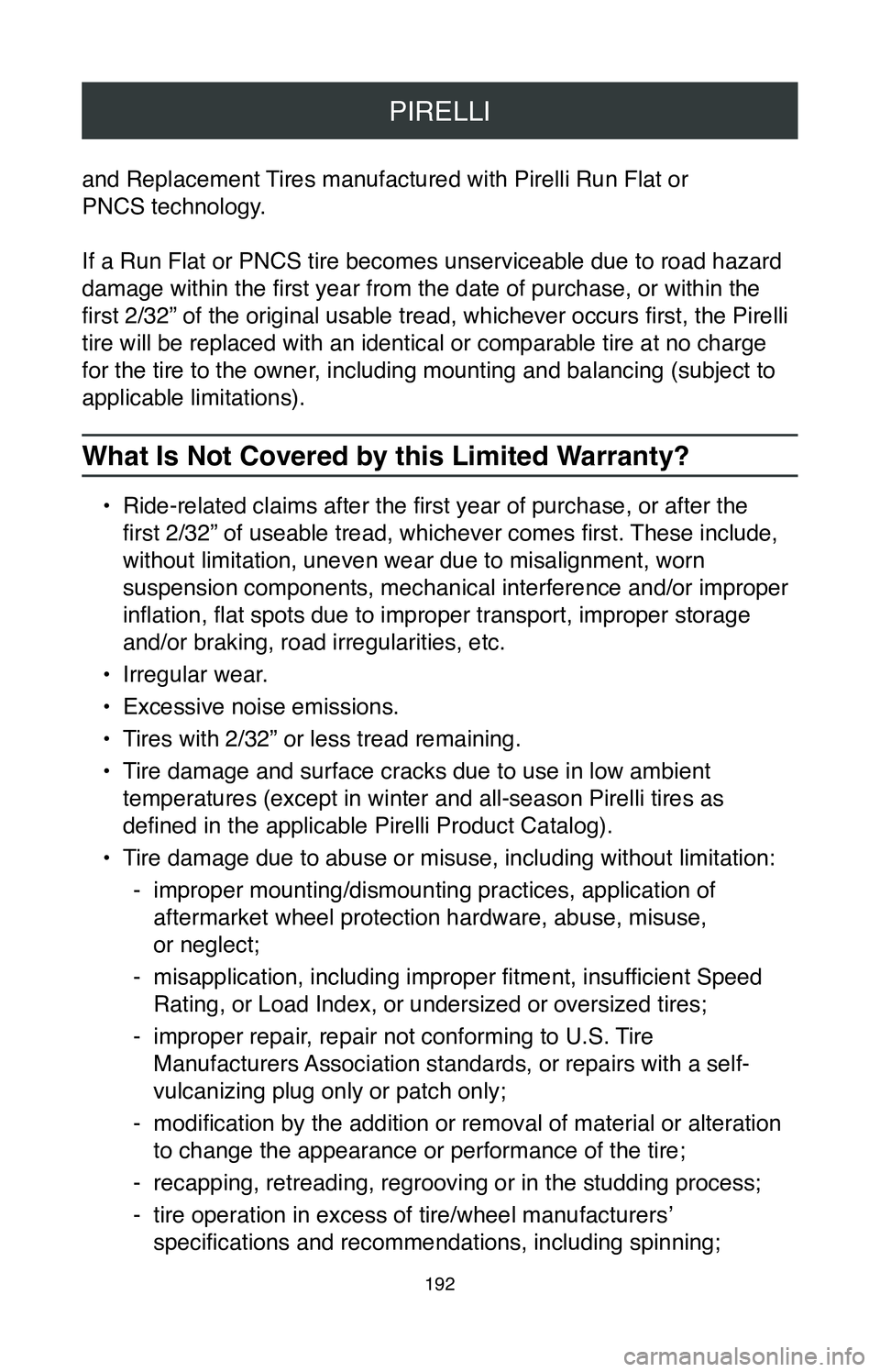
PIRELLI
192
and Replacement Tires manufactured with Pirelli Run Flat or
PNCS technology.
If a Run Flat or PNCS tire becomes unserviceable due to road hazard
damage within the first year from the date of purchase, or within the
first 2/32‚ÄĚ of the original usable tread, whichever occurs first, the Pirelli
tire will be replaced with an identical or comparable tire at no charge \
for the tire to the owner, including mounting and balancing (subject to
applicable limitations).
What Is Not Covered by this Limited Warranty?
‚ÄĘ Ride-related claims after the first year of purchase, or after the
first 2/32‚ÄĚ of useable tread, whichever comes first. These include,
without limitation, uneven wear due to misalignment, worn
suspension components, mechanical interference and/or improper
inflation, flat spots due to improper transport, improper storage
and/or braking, road irregularities, etc.
‚ÄĘ
Irregular wear.
‚ÄĘ
Excessive noise emissions.
‚ÄĘ
Tires with 2/32‚ÄĚ or less tread remaining.
‚ÄĘ
Tire damage and surface cracks due to use in low ambient
temperatures (except in winter and all-season Pirelli tires as
defined in the applicable Pirelli Product Catalog).
‚ÄĘ
Tire damage due to abuse or misuse, including without limitation:
- improper mounting/dismounting practices, application of
aftermarket wheel protection hardware, abuse, misuse,
or neglect;
- misapplication, including improper fitment, insufficient Speed
Rating, or Load Index, or undersized or oversized tires;
-improper repair, repair not conforming to U.S. Tire
Manufacturers Association standards, or repairs with a self-
vulcanizing plug only or patch only;
- modification by the addition or removal of material or alteration
to change the appearance or performance of the tire;
-recapping, retreading, regrooving or in the studding process;
- tire operation in excess of tire/wheel manufacturers’
specifications and recommendations, including spinning;
Page 195 of 260
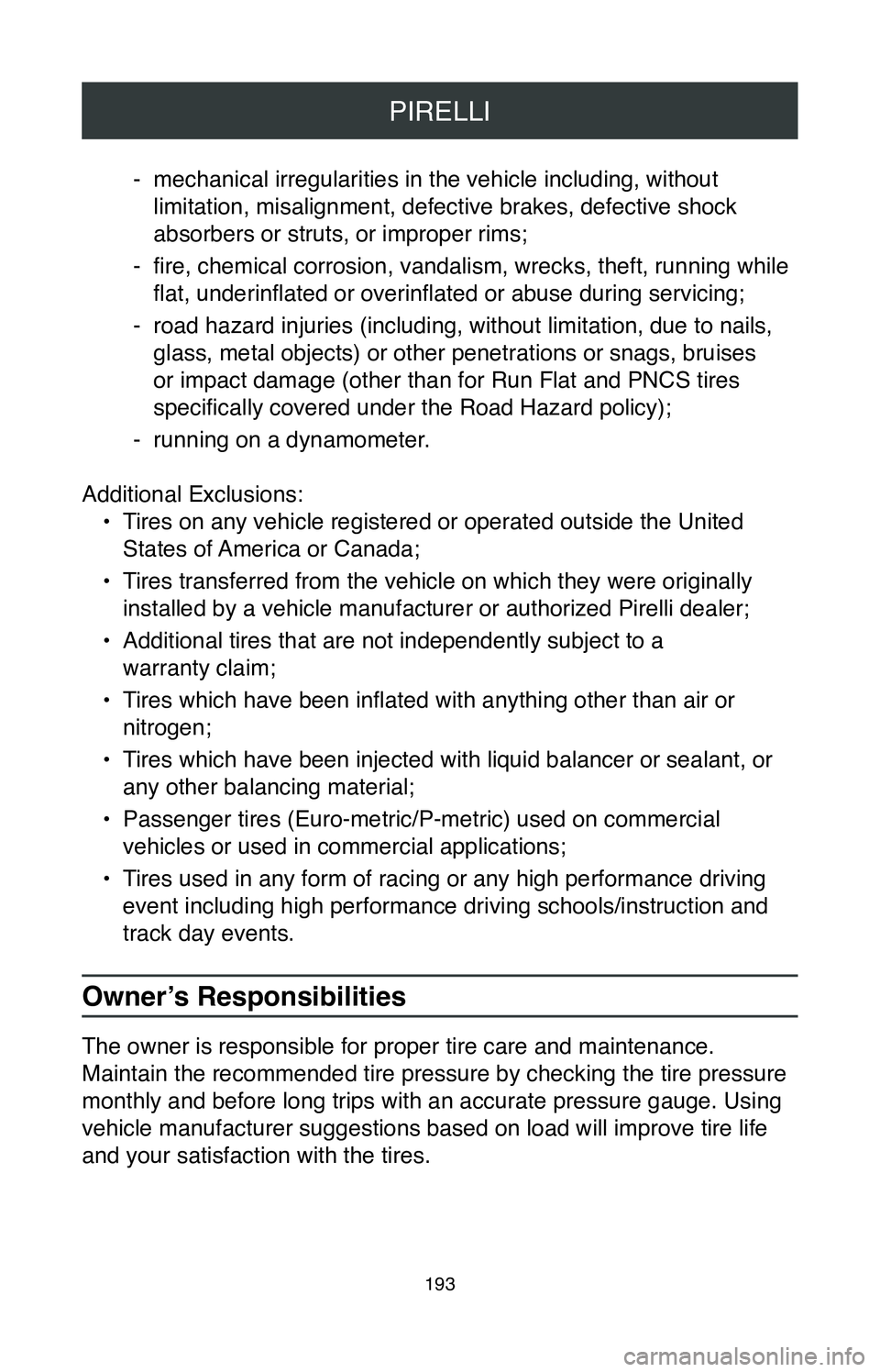
PIRELLI
193
-mechanical irregularities in the vehicle including, without
limitation, misalignment, defective brakes, defective shock
absorbers or struts, or improper rims;
- fire, chemical corrosion, vandalism, wrecks, theft, running while
flat, underinflated or overinflated or abuse during servicing;
- road hazard injuries (including, without limitation, due to nails, glass, metal objects) or other penetrations or snags, bruises
or impact damage (other than for Run Flat and PNCS tires
specifically covered under the Road Hazard policy);
-running on a dynamometer.
Additional Exclusions: ‚ÄĘ
Tires on any vehicle registered or operated outside the United
States of America or Canada;
‚ÄĘ
Tires transferred from the vehicle on which they were originally
installed by a vehicle manufacturer or authorized Pirelli dealer;
‚ÄĘ
Additional tires that are not independently subject to a
warranty claim;
‚ÄĘ
Tires which have been inflated with anything other than air or
nitrogen;
‚ÄĘ
Tires which have been injected with liquid balancer or sealant, or
any other balancing material;
‚ÄĘ
Passenger tires (Euro-metric/P-metric) used on commercial
vehicles or used in commercial applications;
‚ÄĘ
Tires used in any form of racing or any high performance driving
event including high performance driving schools/instruction and
track day events.
Owner’s Responsibilities
The owner is responsible for proper tire care and maintenance.
Maintain the recommended tire pressure by checking the tire pressure
monthly and before long trips with an accurate pressure gauge. Using
vehicle manufacturer suggestions based on load will improve tire life
and your satisfaction with the tires.
Page 196 of 260
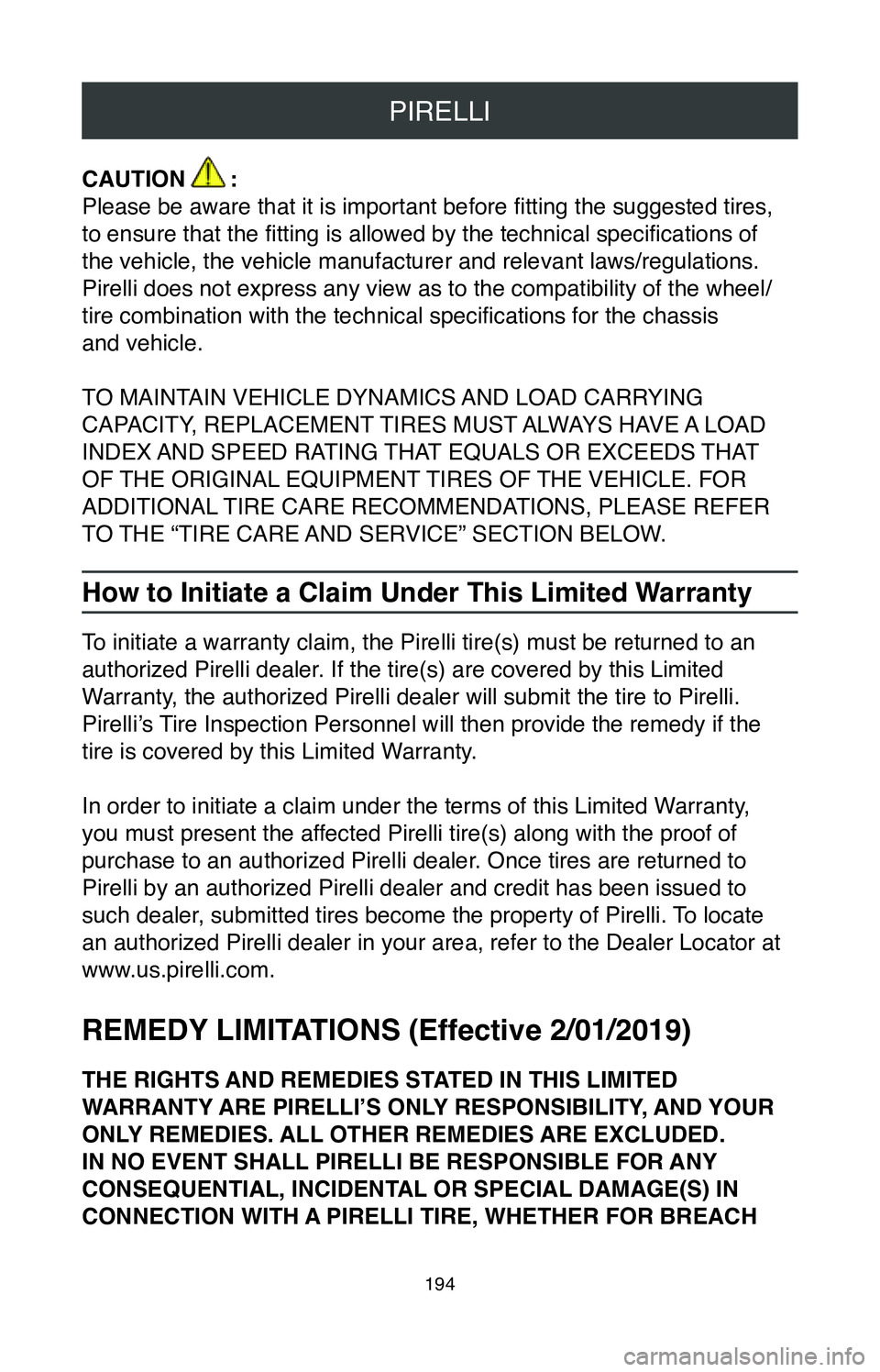
PIRELLI
194
CAUTION :
Please be aware that it is important before fitting the suggested tires,
to ensure that the fitting is allowed by the technical specifications of
the vehicle, the vehicle manufacturer and relevant laws/regulations.
Pirelli does not express any view as to the compatibility of the wheel/
tire combination with the technical specifications for the chassis
and vehicle.
TO MAINTAIN VEHICLE DYNAMICS AND LOAD CARRYING
CAPACITY, REPLACEMENT TIRES MUST ALWAYS HAVE A LOAD
INDEX AND SPEED RATING THAT EQUALS OR EXCEEDS THAT
OF THE ORIGINAL EQUIPMENT TIRES OF THE VEHICLE. FOR
ADDITIONAL TIRE CARE RECOMMENDATIONS, PLEASE REFER
TO THE ‚ÄúTIRE CARE AND SERVICE‚ÄĚ SECTION BELOW.
How to Initiate a Claim Under This Limited Warranty
To initiate a warranty claim, the Pirelli tire(s) must be returned to an
authorized Pirelli dealer. If the tire(s) are covered by this Limited
Warranty, the authorized Pirelli dealer will submit the tire to Pirelli.
Pirelli’s Tire Inspection Personnel will then provide the remedy if the
tire is covered by this Limited Warranty.
In order to initiate a claim under the terms of this Limited Warranty,
you must present the affected Pirelli tire(s) along with the proof of
purchase to an authorized Pirelli dealer. Once tires are returned to
Pirelli by an authorized Pirelli dealer and credit has been issued to
such dealer, submitted tires become the property of Pirelli. To locate
an authorized Pirelli dealer in your area, refer to the Dealer Locator a\
t
www.us.pirelli.com.
REMEDY LIMITATIONS (Effective 2/01/2019)
THE RIGHTS AND REMEDIES STATED IN THIS LIMITED
WARRANTY ARE PIRELLI’S ONLY RESPONSIBILITY, AND YOUR
ONLY REMEDIES. ALL OTHER REMEDIES ARE EXCLUDED.
IN NO EVENT SHALL PIRELLI BE RESPONSIBLE FOR ANY
CONSEQUENTIAL, INCIDENTAL OR SPECIAL DAMAGE(S) IN
CONNECTION WITH A PIRELLI TIRE, WHETHER FOR BREACH
Page 197 of 260
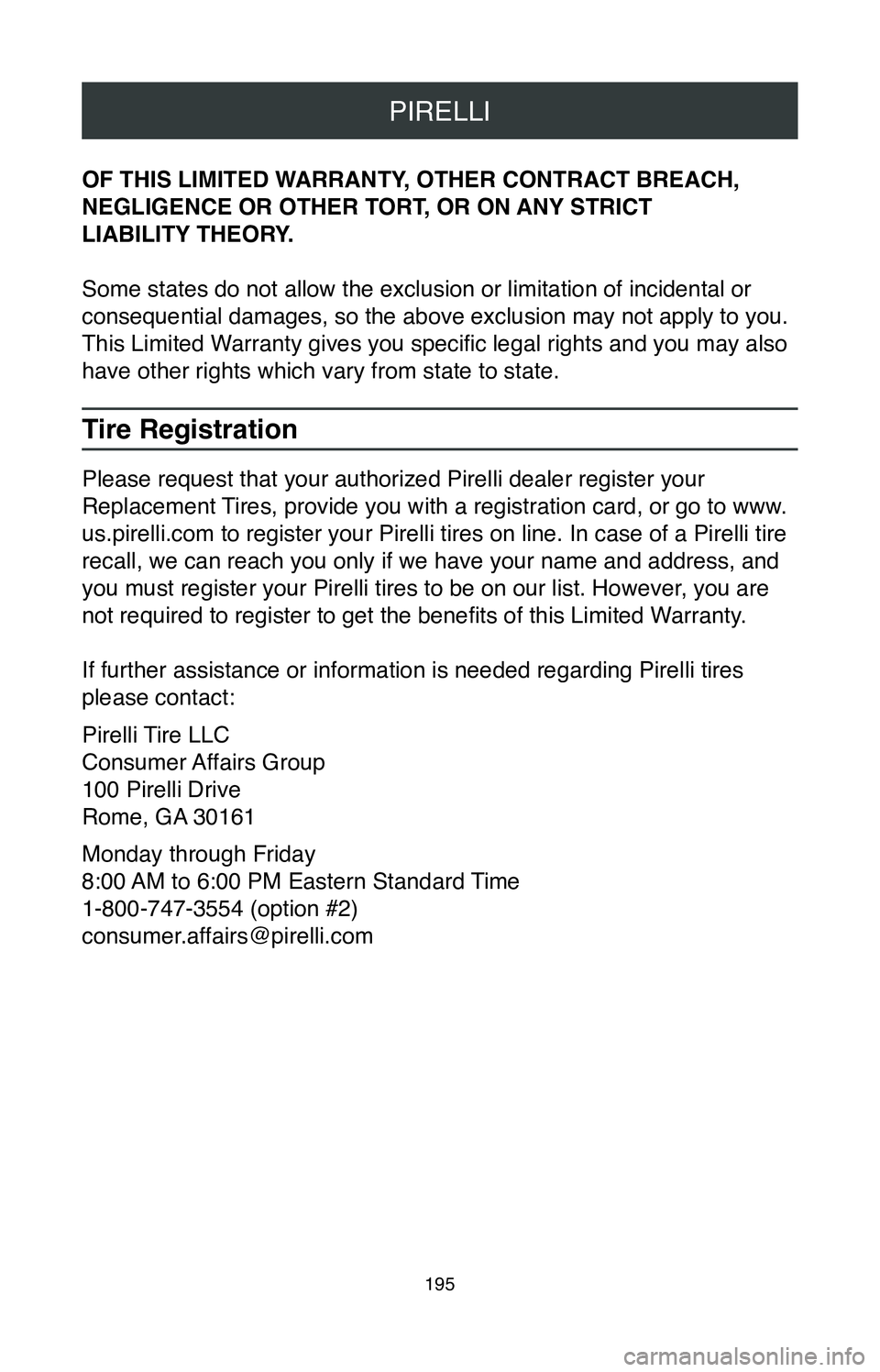
PIRELLI
195
OF THIS LIMITED WARRANTY, OTHER CONTRACT BREACH,
NEGLIGENCE OR OTHER TORT, OR ON ANY STRICT
LIABILITY THEORY.
Some states do not allow the exclusion or limitation of incidental or
consequential damages, so the above exclusion may not apply to you.
This Limited Warranty gives you specific legal rights and you may also
have other rights which vary from state to state.
Tire Registration
Please request that your authorized Pirelli dealer register your
Replacement Tires, provide you with a registration card, or go to www.
us.pirelli.com to register your Pirelli tires on line. In case of a Pire\
lli tire
recall, we can reach you only if we have your name and address, and
you must register your Pirelli tires to be on our list. However, you are
not required to register to get the benefits of this Limited Warranty.
If further assistance or information is needed regarding Pirelli tires
please contact:
Pirelli Tire LLC
Consumer Affairs Group
100 Pirelli Drive
Rome, GA 30161
Monday through Friday
8:00 AM to 6:00 PM Eastern Standard Time
1-800-747-3554 (option #2)
[email protected]
Page 199 of 260
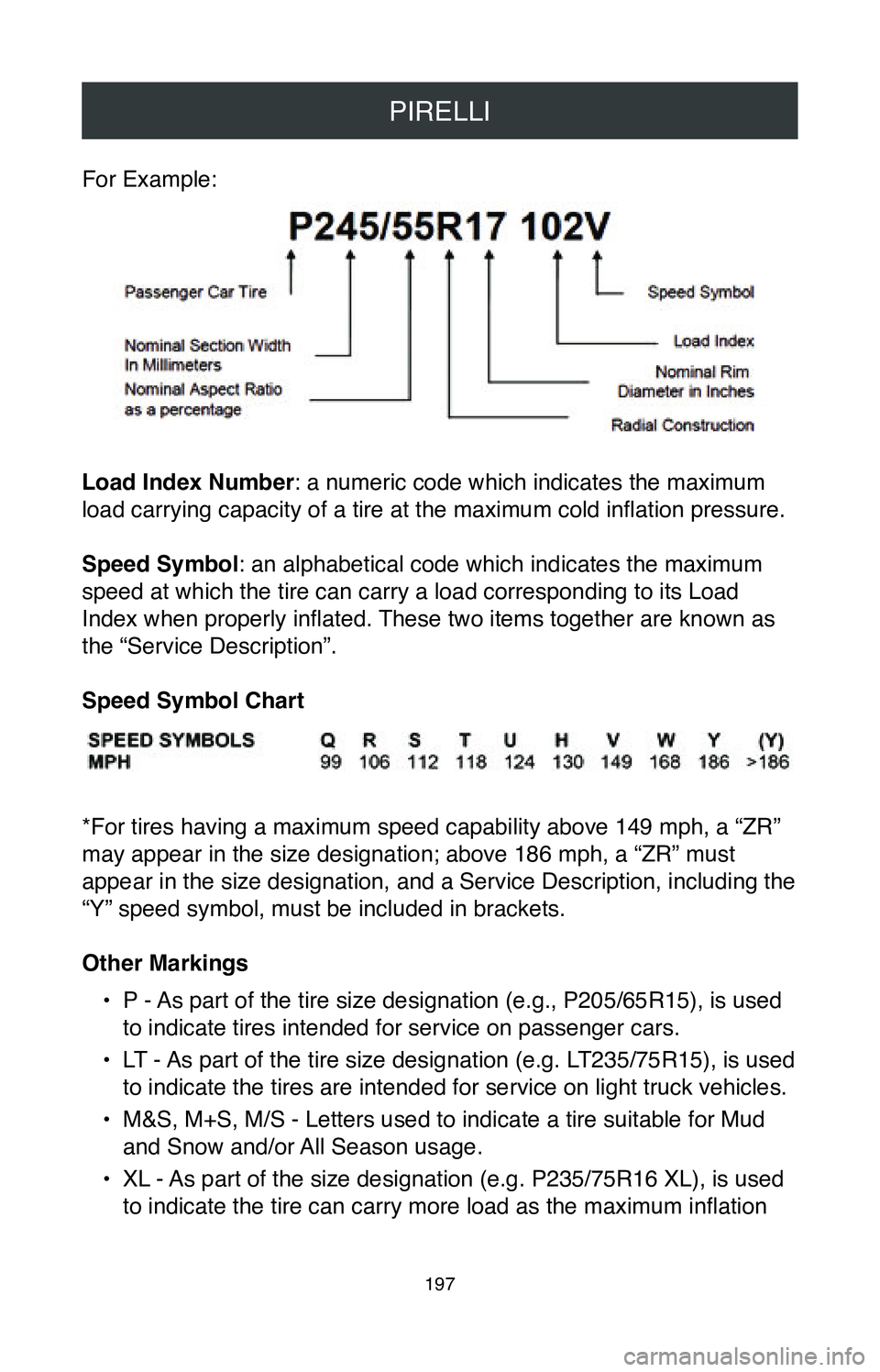
PIRELLI
197
For Example:
Load Index Number: a numeric code which indicates the maximum
load carrying capacity of a tire at the maximum cold inflation pressure.
Speed Symbol: an alphabetical code which indicates the maximum
speed at which the tire can carry a load corresponding to its Load
Index when properly inflated. These two items together are known as
the ‚ÄúService Description‚ÄĚ.
Speed Symbol Chart
*For tires having a maximum speed capability above 149 mph, a ‚ÄúZR‚ÄĚ
may appear in the size designation; above 186 mph, a ‚ÄúZR‚ÄĚ must
appear in the size designation, and a Service Description, including the\
‚ÄúY‚ÄĚ speed symbol, must be included in brackets.
Other Markings
‚ÄĘ
P - As part of the tire size designation (e.g., P205/65R15), is used
to indicate tires intended for service on passenger cars.
‚ÄĘ
LT - As part of the tire size designation (e.g. LT235/75R15), is used
to indicate the tires are intended for service on light truck vehicles.
‚ÄĘ
M&S, M+S, M/S - Letters used to indicate a tire suitable for Mud
and Snow and/or All Season usage.
‚ÄĘ
XL - As part of the size designation (e.g. P235/75R16 XL), is used
to indicate the tire can carry more load as the maximum inflation
Page 200 of 260
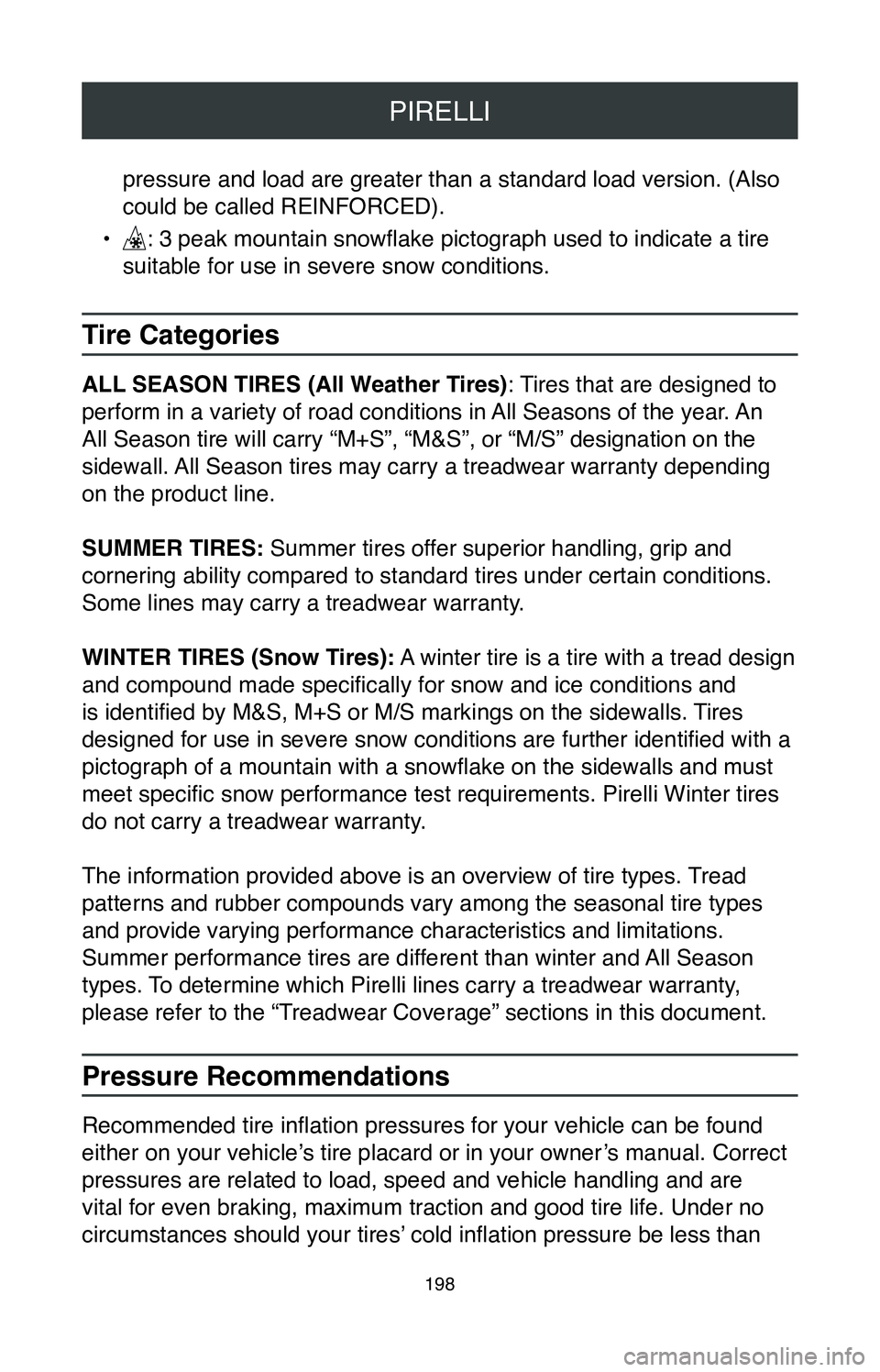
PIRELLI
198
pressure and load are greater than a standard load version. (Also
could be called REINFORCED).
‚ÄĘ
: 3 peak mountain snowflake pictograph used to indicate a tire
suitable for use in severe snow conditions.
Tire Categories
ALL SEASON TIRES (All Weather Tires): Tires that are designed to
perform in a variety of road conditions in All Seasons of the year. An
All Season tire will carry ‚ÄúM+S‚ÄĚ, ‚ÄúM&S‚ÄĚ, or ‚ÄúM/S‚ÄĚ desi\
gnation on the
sidewall. All Season tires may carry a treadwear warranty depending
on the product line.
SUMMER TIRES: Summer tires offer superior handling, grip and
cornering ability compared to standard tires under certain conditions.
Some lines may carry a treadwear warranty.
WINTER TIRES (Snow Tires): A winter tire is a tire with a tread design
and compound made specifically for snow and ice conditions and
is identified by M&S, M+S or M/S markings on the sidewalls. Tires
designed for use in severe snow conditions are further identified with a
pictograph of a mountain with a snowflake on the sidewalls and must
meet specific snow performance test requirements. Pirelli Winter tires
do not carry a treadwear warranty.
The information provided above is an overview of tire types. Tread
patterns and rubber compounds vary among the seasonal tire types
and provide varying performance characteristics and limitations.
Summer performance tires are different than winter and All Season
types. To determine which Pirelli lines carry a treadwear warranty,
please refer to the ‚ÄúTreadwear Coverage‚ÄĚ sections in this document.
Pressure Recommendations
Recommended tire inflation pressures for your vehicle can be found
either on your vehicle’s tire placard or in your owner’s manual. Correct
pressures are related to load, speed and vehicle handling and are
vital for even braking, maximum traction and good tire life. Under no
circumstances should your tires’ cold inflation pressure be less than
Page 201 of 260
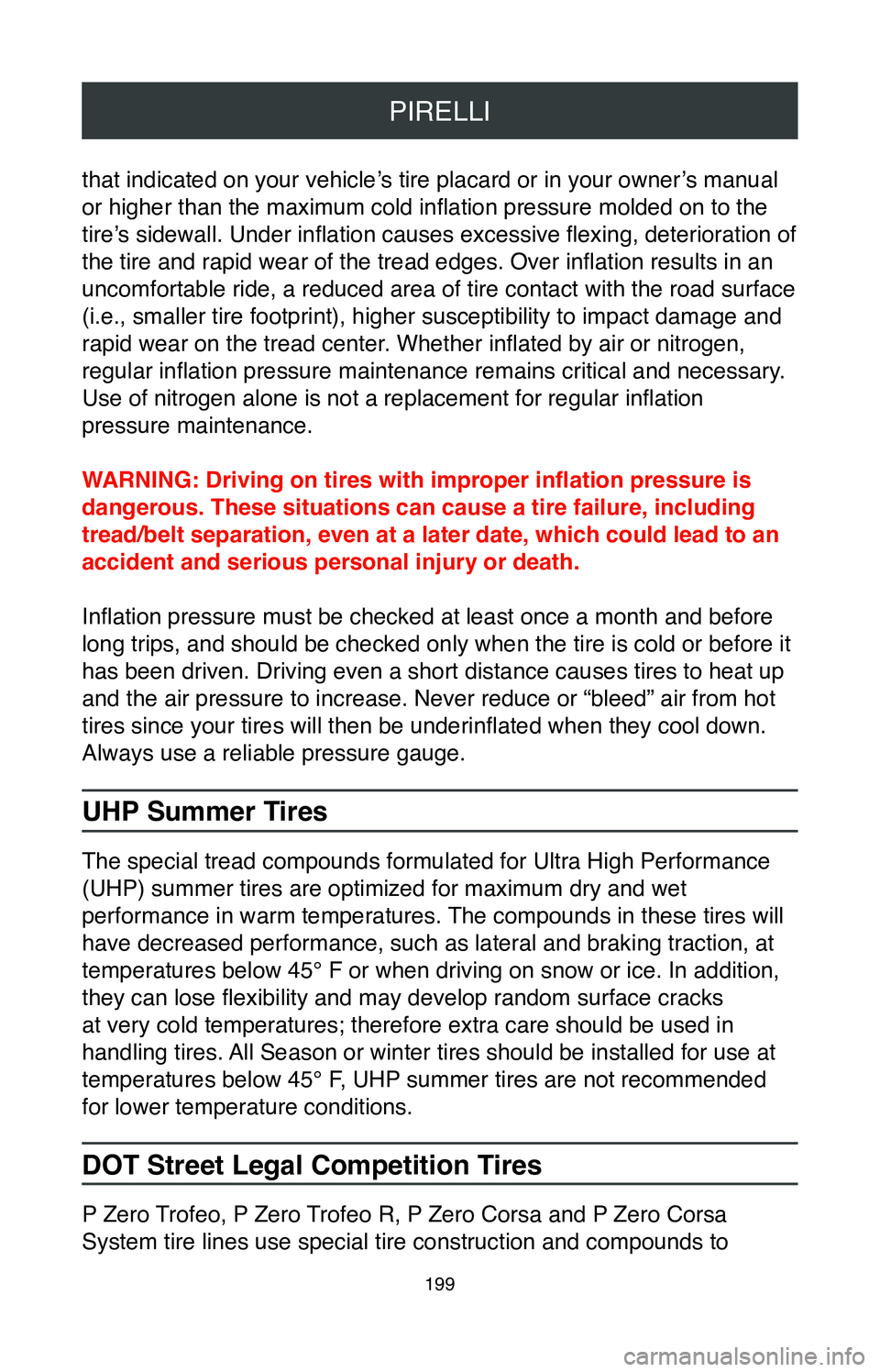
PIRELLI
199
that indicated on your vehicle’s tire placard or in your owner’s manual
or higher than the maximum cold inflation pressure molded on to the
tire’s sidewall. Under inflation causes excessive flexing, deterioration of
the tire and rapid wear of the tread edges. Over inflation results in an
uncomfortable ride, a reduced area of tire contact with the road surface\
(i.e., smaller tire footprint), higher susceptibility to impact damage and
rapid wear on the tread center. Whether inflated by air or nitrogen,
regular inflation pressure maintenance remains critical and necessary.
Use of nitrogen alone is not a replacement for regular inflation
pressure maintenance.
WARNING: Driving on tires with improper inflation pressure is
dangerous. These situations can cause a tire failure, including
tread/belt separation, even at a later date, which could lead to an
accident and serious personal injury or death.
Inflation pressure must be checked at least once a month and before
long trips, and should be checked only when the tire is cold or before i\
t
has been driven. Driving even a short distance causes tires to heat up
and the air pressure to increase. Never reduce or ‚Äúbleed‚ÄĚ air from\
hot
tires since your tires will then be underinflated when they cool down.
Always use a reliable pressure gauge.
UHP Summer Tires
The special tread compounds formulated for Ultra High Performance
(UHP) summer tires are optimized for maximum dry and wet
performance in warm temperatures. The compounds in these tires will
have decreased performance, such as lateral and braking traction, at
temperatures below 45¬į F or when driving on snow or ice. In addition,\
they can lose flexibility and may develop random surface cracks
at very cold temperatures; therefore extra care should be used in
handling tires. All Season or winter tires should be installed for use at
temperatures below 45¬į F, UHP summer tires are not recommended
for lower temperature conditions.
DOT Street Legal Competition Tires
P Zero Trofeo, P Zero Trofeo R, P Zero Corsa and P Zero Corsa
System tire lines use special tire construction and compounds to
Page 202 of 260
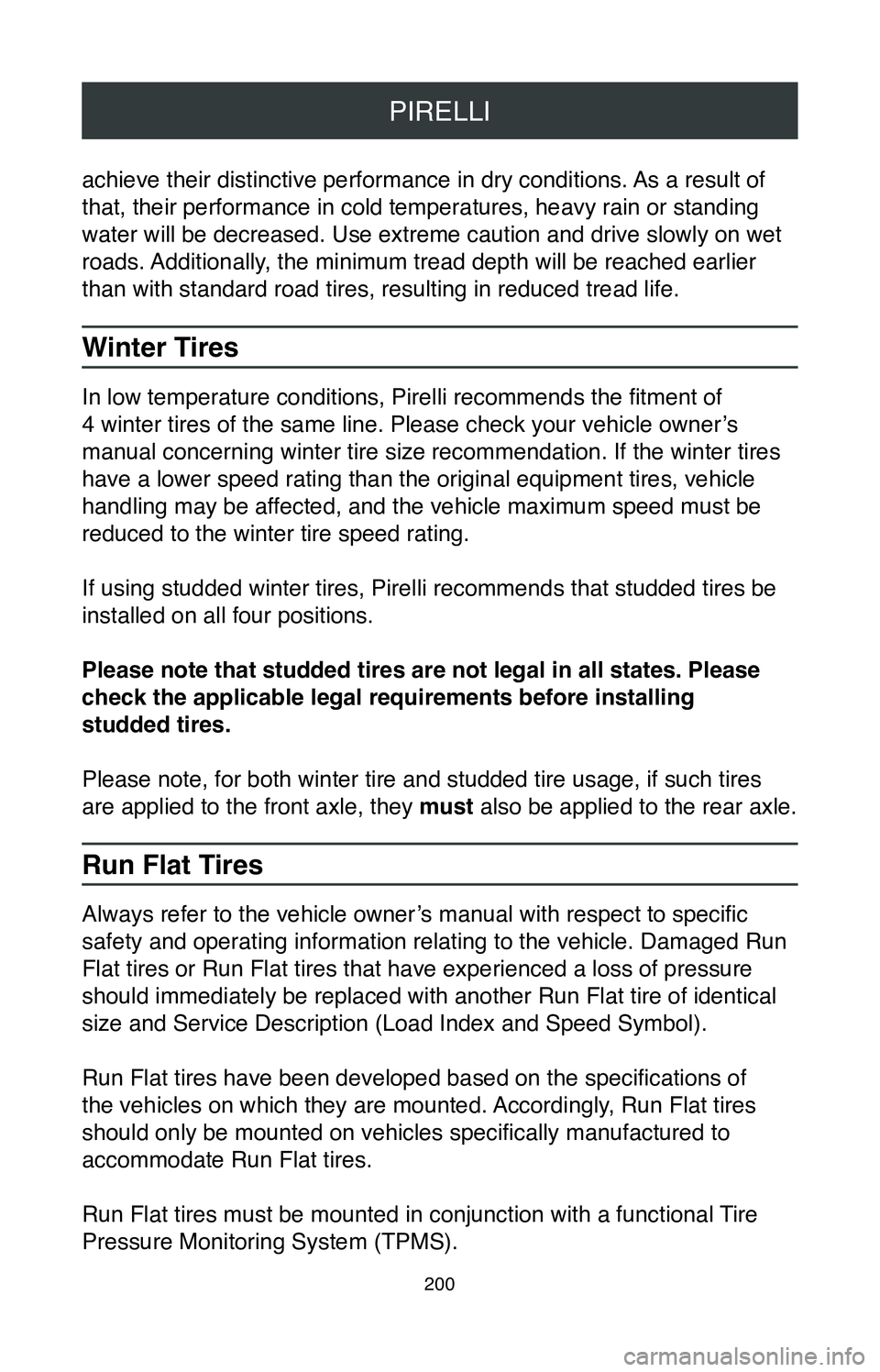
PIRELLI
200
achieve their distinctive performance in dry conditions. As a result of
that, their performance in cold temperatures, heavy rain or standing
water will be decreased. Use extreme caution and drive slowly on wet
roads. Additionally, the minimum tread depth will be reached earlier
than with standard road tires, resulting in reduced tread life.
Winter Tires
In low temperature conditions, Pirelli recommends the fitment of
4 winter tires of the same line. Please check your vehicle owner’s
manual concerning winter tire size recommendation. If the winter tires
have a lower speed rating than the original equipment tires, vehicle
handling may be affected, and the vehicle maximum speed must be
reduced to the winter tire speed rating.
If using studded winter tires, Pirelli recommends that studded tires be \
installed on all four positions.
Please note that studded tires are not legal in all states. Please
check the applicable legal requirements before installing
studded tires.
Please note, for both winter tire and studded tire usage, if such tires \
are applied to the front axle, they must also be applied to the rear axle.
Run Flat Tires
Always refer to the vehicle owner’s manual with respect to specific
safety and operating information relating to the vehicle. Damaged Run
Flat tires or Run Flat tires that have experienced a loss of pressure
should immediately be replaced with another Run Flat tire of identical
size and Service Description (Load Index and Speed Symbol).
Run Flat tires have been developed based on the specifications of
the vehicles on which they are mounted. Accordingly, Run Flat tires
should only be mounted on vehicles specifically manufactured to
accommodate Run Flat tires.
Run Flat tires must be mounted in conjunction with a functional Tire
Pressure Monitoring System (TPMS).